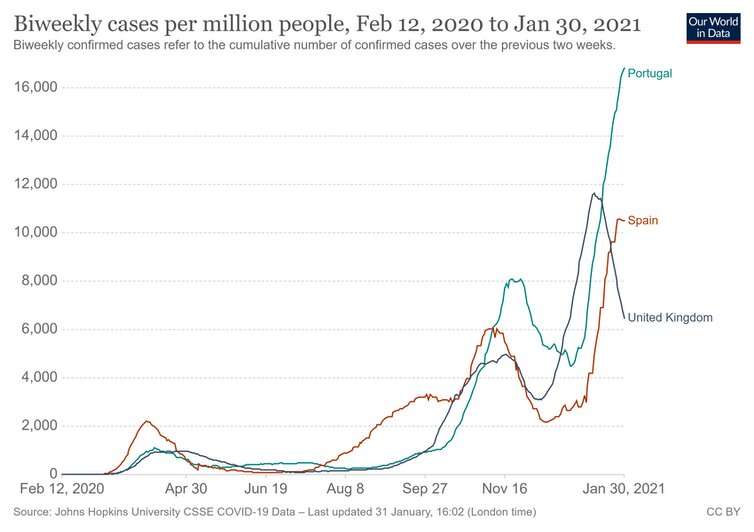Coronavirus: Why is Portugal being hit so hard?

Good news about COVID vaccines has been in abundance in the past few weeks. In the meantime, though, the pandemic continues to accelerate globally, with Europe accounting for 34% of new cases worldwide. One country in particular has been hit hard: Portugal.
Looking at the last two weeks’ data, Portugal has both the highest case rate (16,829 per million people) and death rate (340 deaths per million people). These numbers exceed both the UK (case rates 6,480, death rate 250 per million) and the US (case rates 6,920, death rate 131 per million) by a considerable margin. Portugal’s neighbor, Spain, also has lower numbers (case rates 10,500 and deaths 107 per million).
Nearly half of Portugal’s COVID deaths were reported in January, and the country’s health system is on the brink of collapse. Several European nations, including Germany and Austria, are stepping in to help.
Early success
It’s an unfortunate turnaround for a country that handled the early stages of the pandemic so well. Portugal was quick to deploy interventions, including imposing a full national lockdown when there were a few hundred recorded cases in the country. (Spain only locked down when they had several thousand known cases.)
A contributing factor for the recent increases may well have been the relaxing of restrictions, such as allowing people to mix more. And if there is a baseline level of infectious disease, then an increase in case numbers will follow.
Notably, the recent upward trajectory points to population mixing taking place over the festive period. On December 28, Portugal case rates were 4,484 per million people, their lowest point in recent times and around a quarter of what they are now, a month later. These increases will reflect transmission over the festive period.
Christmas was an accident waiting to happen.
Perfect storm
The so-called UK variant (B117) has been increasingly detected in Portugal in recent weeks, which may have added to the perfect storm of factors that have led to the record-breaking numbers we now see. This variant is more transmissible, and perhaps also more lethal.
To add to the misery, the healthcare system is extremely understaffed, with 23,000 doctors in Portugal having tested positive for COVID. World Bank data shows there are about five doctors per 1,000 people in Portugal. With a population of about 10 million, this would translate to around 50,000 doctors in the country. So the reporting suggests that around half of the country’s medics have been infected with coronavirus. If that is correct, then it’s an incredible number.
It’s very hard to directly compare with data from other countries due to different time points, sample sizes and so on. But, if we reflect cautiously on data from the UK, the Office for National Statistics reported in July 2020 that 1.6% of patient-facing healthcare workers tested positive for COVID. Historically, infections transmitted in hospitals has been very high in Portugal compared with other wealthy countries. Perhaps we are observing that here during the pandemic.
On January 15, Portugal imposed another national lockdown. This includes the closures of non-essential services such as gyms, barbershops and museums. This intervention should very soon start to be reflected by reductions in the new daily cases.
There are some limited restrictions on international travel, for example, with the UK and Portugal eyeing each other’s caseloads with suspicion and banning flights between the two countries. However, connections with other countries seem to be relatively relaxed, which runs the risk of importing new cases and possibly new variants.
These new cases would probably be few, but then COVID reached all corners of the globe in a few months, with a just a handful of imported cases into each country. It seems to me to be a risky approach at this point in time, and a requirement for all inbound travelers to quarantine should be the policy.
Source: Read Full Article


